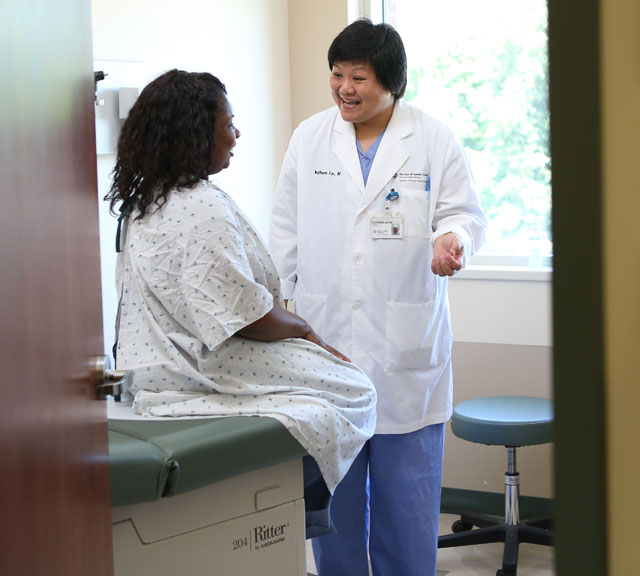The ABCs of Cesarean Sections

Answer a few questions and we'll provide you with a list of primary care providers that best fit your needs.
Cesarean section (C-section) – a surgery in which a cut is made in a pregnant woman’s abdomen in order to remove her baby – sounds like a very modern solution. Truth is, the procedure has been around since ancient times.
While historians debate the specifics, they’re pretty certain these ancient C-sections were used to rescue babies from the wombs of mothers who were dead or dying. All this was done without the benefit of anesthesia or antibiotics.
Happily, today’s C-sections have a very different role than in centuries past and are far safer and virtually pain-free. “Vaginal delivery remains the preferred birthing option,” says L. William Rettig, MD, obstetrician/gynecologist at Lifestages – Samaritan Centers For Women. “However, there are situations in which C-sections are safe and necessary.”
Why Have a C-Section?
Births don’t always proceed as nature intended. For the well-being of baby, mom or both, a C-section may be necessary with:
- Failure of labor to progress This happens when the cervix doesn’t open wide enough to allow the baby to move down the birth canal.
- Fetal distress “If we see signs on the fetal heart rate monitor that the baby is in distress in utero (in the womb), we may cut labor short” and move to the operating room, explains Dr. Rettig.
- Multiple fetuses If there are two or more babies, it’s likely that at least one will not be in the proper position to be born vaginally.
- Breech presentation If the baby is positioned to come through the birth canal feet- or buttocks-first instead of head-first, a C-section may be necessary.
- Placenta previa This condition involves a placenta growing low in the uterus, blocking the cervix and therefore creating a number of complications during labor and delivery.
- An unusually large baby
- Maternal infections A Cesarean may protect infants from infections, such as HIV or herpes.
- Maternal medical conditions Certain chronic conditions such as diabetes or high blood pressure may make vaginal delivery riskier for some women.
Sometimes, physicians are asked if they can perform elective C-sections (for non-medical reasons). “This is not something we promote or encourage,” says Dr. Rettig, “and it’s very rare.”
What to Expect
 Often, C-sections are not something you have time to prepare for. So if you’re pregnant, it’s important to know in advance what they entail. According to Dr. Rettig, “The specifics vary depending on whether it’s an emergency or planned Cesarean.” In general, however, here’s what you can expect:
Often, C-sections are not something you have time to prepare for. So if you’re pregnant, it’s important to know in advance what they entail. According to Dr. Rettig, “The specifics vary depending on whether it’s an emergency or planned Cesarean.” In general, however, here’s what you can expect:
Before
C-sections are performed in an operating room on a labor and delivery unit. Before surgery, a nurse will “prep” (clean and shave) your abdomen. A catheter will be inserted into your urethra to collect urine, and an intravenous line will be started in your arm or hand to provide you with fluids. Your legs may be strapped to the operating table for safety reasons.
An anesthesiologist or a registered nurse anesthetist will numb you from the chest down, using regional anesthesia or an epidural. General anesthesia is rarely used, explains Dr. Rettig. It presents more risk, and doesn’t allow the mother to participate in the birthing process.
During
To open the abdomen, your physician will choose one of two cuts (depending on your preference and your health.) A low-transverse or “bikini incision” (a horizontal cut at the lower abdomen) is the most common because it heals well and enables a woman to deliver vaginally during future births. Less frequently, physicians use a vertical cut that extends from the belly button to the pubic hairline.
There are situations in which C-sections are safe and necessary
The incision is made just wide enough to allow the physician to remove the baby from the womb. After the umbilical cord is cut, the incision area is cleaned and stitched. The entire Cesarean procedure, from start to finish, takes about one hour.
After
“If the patient is young and healthy, she’ll usually bounce right back,” says Dr. Rettig, although the recovery is still more involved than with a vaginal birth.
After a C-section, the mother will likely be in the hospital for two days, and the recovery period can take a solid six to eight weeks. “You’ll need to slow down. At home, you’ll need additional help and additional pain medicine,” Dr. Rettig cautions.
Gentle C-Section: A Family-Friendly Approach
Typically, women undergoing Cesareans report a less-than-satisfactory childbirth experience compared with those delivering vaginally, according to research from the National Institutes of Health. This can make them more prone to postnatal depression, bonding difficulties and breastfeeding problems.
To counter this, Dr. Rettig says “Gentle C-sections” are becoming more popular in hospitals. A Gentle C-section makes the experience feel more like a birth than a surgery.
With this approach, the room is calm and quiet, and the partner sits near the mom’s head. The mom is draped in such a way as to allow her and her partner to see the baby being delivered. Whenever possible, the baby is immediately given to mom for skin-on-skin contact, which encourages immediate bonding. This also allows mom and baby to begin the breastfeeding process right away, which leads to a greater likelihood of success.
Answer a few questions and we'll provide you with a list of primary care providers that best fit your needs.
Source: Office on Women’s Health, U.S. Department of Health and Human Services; National Institutes of Health; American College of Obstetrics and Gynecology





